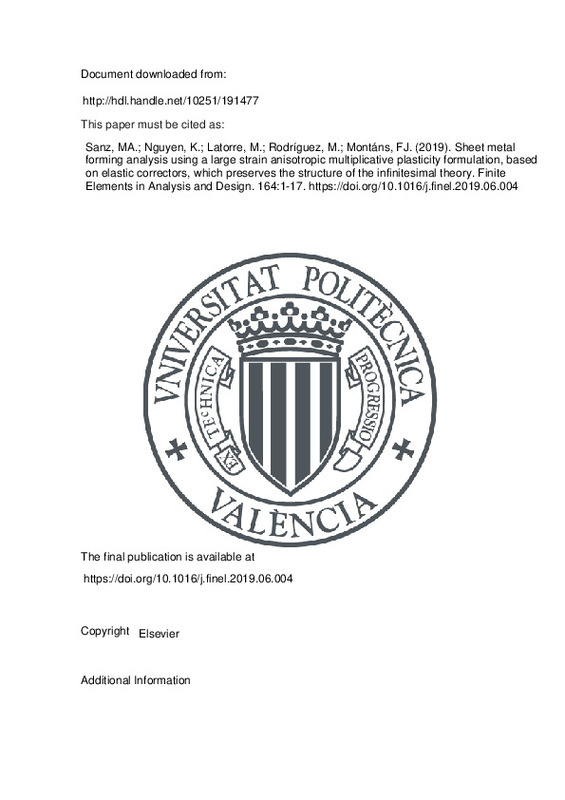JavaScript is disabled for your browser. Some features of this site may not work without it.
Buscar en RiuNet
Listar
Mi cuenta
Estadísticas
Ayuda RiuNet
Admin. UPV
Sheet metal forming analysis using a large strain anisotropic multiplicative plasticity formulation, based on elastic correctors, which preserves the structure of the infinitesimal theory
Mostrar el registro sencillo del ítem
Ficheros en el ítem
| dc.contributor.author | Sanz, Miguel A.
|
es_ES |
| dc.contributor.author | Nguyen, K.
|
es_ES |
| dc.contributor.author | Latorre, Marcos
|
es_ES |
| dc.contributor.author | Rodríguez, Manuel
|
es_ES |
| dc.contributor.author | Montáns, Francisco Javier
|
es_ES |
| dc.date.accessioned | 2023-01-26T19:01:50Z | |
| dc.date.available | 2023-01-26T19:01:50Z | |
| dc.date.issued | 2019-10-15 | es_ES |
| dc.identifier.issn | 0168-874X | es_ES |
| dc.identifier.uri | http://hdl.handle.net/10251/191477 | |
| dc.description.abstract | [EN] Sheet metal forming is a very important process in industry to create a wide variety of goods. The analysis of local ductility and residual stresses is important both to assess the viability of the manufacturing process and the reliability of the resulting elements in service. An example is crash-worthiness, where remaining ductility and residual stresses govern the safety of the overall structure during the impact. A main ingredient of finite element simulations for sheet metal forming in industry is a robust continuum-based computational algorithm for large strain elastoplasticity which includes both elastic and plastic anisotropy, as well as mixed hardening. The theory should use exactly-integrable (conservative) elastic and hardening behaviors based on physically motivated proper state variables and, if possible, result in a simple integration algorithm. In this work we implement a novel large strain formulation for anisotropic hyperelasto-plasticity in a user subroutine of the commercial program ADINA to perform sheet metal forming simulations, testing the robustness and suitability of the model for industry, as well as its accuracy. The formulation is based on a new approach to the treatment of large strain kinematics, using logarithmic elastic corrector rates instead of plastic rates. Furthermore, kinematic hardening is formulated without an explicit backstress. We compare and discuss the results with those in the literature which use alternative frameworks. | es_ES |
| dc.description.sponsorship | Partial financial support for this work has been given by grant PGC 2018-097257-B-C32 from the Direccion General de proyectos de Investigacion of the Ministerio de Economia y Competividad of Spain. The ADINA program license used in this work has been a courtesy of ADINA R&D to the UPM | es_ES |
| dc.language | Inglés | es_ES |
| dc.publisher | Elsevier | es_ES |
| dc.relation.ispartof | Finite Elements in Analysis and Design | es_ES |
| dc.rights | Reconocimiento - No comercial - Sin obra derivada (by-nc-nd) | es_ES |
| dc.subject | Large strains | es_ES |
| dc.subject | Anisotropic plasticity | es_ES |
| dc.subject | Sheet metal forming | es_ES |
| dc.subject | Logarithmic strains | es_ES |
| dc.subject | Multiplicative decomposition | es_ES |
| dc.subject | Hill plasticity | es_ES |
| dc.title | Sheet metal forming analysis using a large strain anisotropic multiplicative plasticity formulation, based on elastic correctors, which preserves the structure of the infinitesimal theory | es_ES |
| dc.type | Artículo | es_ES |
| dc.identifier.doi | 10.1016/j.finel.2019.06.004 | es_ES |
| dc.relation.projectID | info:eu-repo/grantAgreement/AEI/Plan Estatal de Investigación Científica y Técnica y de Innovación 2017-2020/PGC2018-097257-B-C32/ES/MODELING OF THE MECHANICAL ENVIRONMENT AND CELL BEHAVIOR IN GLIOBLASTOMA GROWTH/ | es_ES |
| dc.relation.projectID | info:eu-repo/grantAgreement/MICINN//PGC 2018-097257-B-C32//MODELING OF THE MECHANICAL ENVIRONMENT AND CELL BEHAVIOR IN GLIOBLASTOMA GROWTH/ | es_ES |
| dc.rights.accessRights | Abierto | es_ES |
| dc.description.bibliographicCitation | Sanz, MA.; Nguyen, K.; Latorre, M.; Rodríguez, M.; Montáns, FJ. (2019). Sheet metal forming analysis using a large strain anisotropic multiplicative plasticity formulation, based on elastic correctors, which preserves the structure of the infinitesimal theory. Finite Elements in Analysis and Design. 164:1-17. https://doi.org/10.1016/j.finel.2019.06.004 | es_ES |
| dc.description.accrualMethod | S | es_ES |
| dc.relation.publisherversion | https://doi.org/10.1016/j.finel.2019.06.004 | es_ES |
| dc.description.upvformatpinicio | 1 | es_ES |
| dc.description.upvformatpfin | 17 | es_ES |
| dc.type.version | info:eu-repo/semantics/publishedVersion | es_ES |
| dc.description.volume | 164 | es_ES |
| dc.relation.pasarela | S\472131 | es_ES |
| dc.contributor.funder | Ministerio de Ciencia e Innovación | es_ES |
| dc.subject.ods | 09.- Desarrollar infraestructuras resilientes, promover la industrialización inclusiva y sostenible, y fomentar la innovación | es_ES |







![[Cerrado]](/themes/UPV/images/candado.png)

